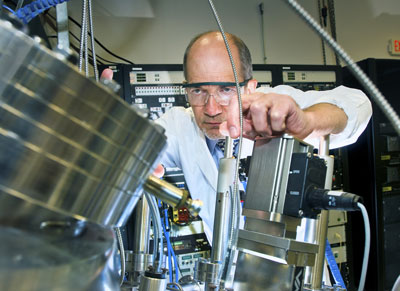| Jun 10, 2011 |
Ultrathin copper-oxide layers behave like quantum spin liquid
|
|
(Nanowerk News) Magnetic studies of ultrathin slabs of copper-oxide materials reveal that at very low temperatures, the thinnest, isolated layers lose their long-range magnetic order and instead behave like a "quantum spin liquid" — a state of matter where the orientations of electron spins fluctuate wildly. This unexpected discovery by scientists at the U.S. Department of Energy's (DOE) Brookhaven National Laboratory and collaborators at the Paul Scherrer Institute in Switzerland may offer support for the idea that this novel condensed state of matter is a precursor to the emergence of high-temperature superconductivity — the ability to carry current with no resistance. |
|
The hope is that this research, just published online in Physical Review Letters ("Two-Dimensional Magnetic and Superconducting Phases in Metal-Insulator La2-xSrxCuO4 Superlattices Measured by Muon-Spin Rotation"), will lead to a deeper understanding of the physics of high-temperature superconductivity and advance the quest for new and better superconductors for meeting the nation's and world's energy needs.
|
 |
| Ivan Bozovic
|
|
The idea of quantum spin liquids is credited to Nobel laureate Philip W. Anderson, who also proposed the possible link to the emergence of high-temperature superconductivity when copper-oxide, or "cuprate," materials are doped with mobile charge carriers — that is, when atoms supplying additional electrons or electron vacancies are added. However, some past experimental findings haven't supported this proposal: Without doping, lanthanum-copper-oxide, one of the most studied cuprates, shows a form of long-range magnetic order known as anti-ferromagnetism — where spin orientations on adjacent electrons alternately point in exactly opposite directions — even at room temperature. But the new Brookhaven Lab/Scherrer Institute experiments suggest a different picture when one looks at thin enough layers.
|
|
"The crystal structure of lanthanum-copper-oxide is layered; it consists of parallel copper-oxide and lanthanum-oxide sheets," explained Brookhaven physicist Ivan Bozovic, one of the lead authors on the paper. "The interaction among the spins within one copper-oxide plane is strong, while their interaction with the spins in the nearest copper-oxide plane (about 0.66 nanometers away) is ten thousand times weaker. Still, this weak interaction between layers may be sufficient to suppress fluctuations and stabilize the anti-ferromagnetic order."
|
|
The key to finding out if there was fluctuation-suppressing interaction among layers was to look for magnetic order in thinner films, with fewer layers and better insulation.
|
|
Bozovic used a specialized atomic-layer-by-layer molecular beam epitaxy method he's developed to assemble lanthanum-copper-oxide samples with varying numbers of layers. The layers were well separated and insulated to prevent any "crosstalk." The thickness was controlled with atomic precision and varied digitally, down to a single copper-oxide plane. This precision was critically important for the success of the experiment.
|
|
These unique samples were studied at the Paul Scherrer Institute by Elvezio Morenzoni and his team, who had developed an exquisite diagnostic technique called low-energy muon spin spectroscopy to detect and investigate magnetism in such ultrathin layers.
|
|
The magnetic measurements revealed that when the slabs contained four or more copper-oxide layers, they showed anti-ferromagnetic ordering — just like thick, bulk crystals of the same materials, and even up to the same temperature. However, thinner slabs that contained just one or two copper-oxide layers showed an unexpected result: "While the magnetic moments, or spins, were still present and had about the same magnitude, there was no long-range static anti-ferromagnetic order, not even on the scale of a few nanometers. Rather, the spins were fluctuating wildly, changing their direction very fast," Bozovic said.
|
|
Even more telling, this effect was stronger the lower the temperature of the sample. "That means these fluctuations could not be of thermal origin and must be of quantum origin — quantum objects fluctuate even at zero temperature," Bozovic explained.
|
|
"Altogether, this experiment indicates that once a copper-oxide plane is well isolated and not interacting with other such layers, it in fact seems to behave, at low temperature, like some sort of quantum spin liquid." Bozovic said. So perhaps the idea that high-temperature superconductivity emerges from this quantum spin liquid state could, after all, be true.
|
|
"We certainly need to do more experiments to test the implications of our discovery and how it relates to this theoretical prediction," Bozovic said.
|

